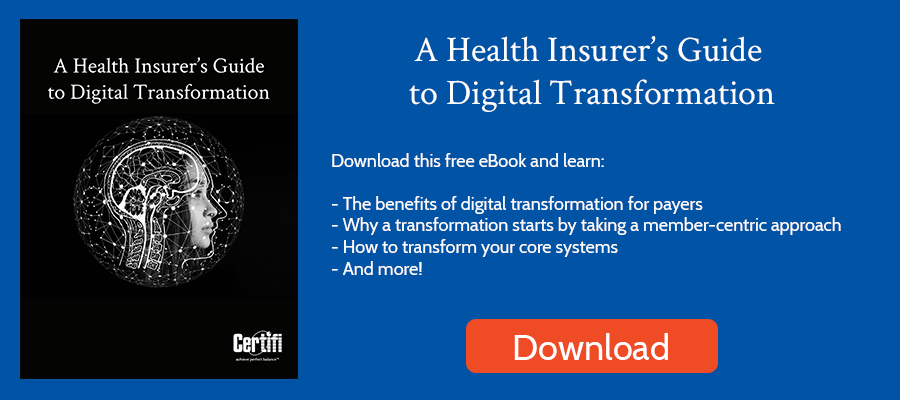As the COVID-19 pandemic raged, many consumers got their first taste of virtual health. And apparently, they enjoyed the experience. A recent survey from Press Ganey found that more than 1/3 of patients have used telehealth in the past year — a 38% increase since 2019. Usage among Baby Boomers “surged” during the same period.
As a result, many payers launched virtual-first health plans in 2021 for the 2022 plan year to meet that consumer demand. Here’s an overview of what defines a virtual-first health plan, the benefits and obstacles for health insurers, and the future of virtual first plans.
What are virtual-first plans?
Definitions for virtual-first plans vary. But at their core, they typically assign a virtual doctor to be the primary contact for a member. The member starts their healthcare journey with a virtual doctor’s visit or telehealth visit. That doctor may then refer them to an in-network, in-person visit, if necessary. Though not all virtual-first plans require that a virtual visit be the first point of contact, many do.
For members, virtual-first health plans can save money. Many leverage lower premiums or low to non-existent co-pays for virtual visits. Most claim that service is faster, providing members with the ability to access an appointment within minutes. Convenience often extends to 24/7 access to virtual service. For members who don’t mind virtual care, virtual-first health plans can be a convenient, less expensive way to receive medical care.
Why do health insurers create virtual-first plans?
For many reasons, but largely because they can contain costs. Because virtual-first health plans typically require a member to have a virtual visit before receiving care, they can better help members navigate the complex healthcare system. For example, they can point patients to urgent care settings instead of emergency rooms, saving significantly in the process.
Consumer demand also plays a role. The COVID-19 pandemic showed many consumers how convenient and flexible virtual healthcare could be. With more digital-native consumers entering the market, demand for virtual health plans will likely continue to grow.
It can also make an insurer more competitive. Many individuals base insurance decisions on the healthcare network available. Virtual plans that offer a virtual primary care provider to some degree eliminate that consideration.
Finally, many insurers think virtual-first plans may result in better preventive care. Why? Because they feel many consumers eschew preventive care because it’s so inconvenient. Being able to manage preventive services in a virtual environment may help members access more preventive care services.
What obstacles do insurers need to overcome?
There are several obstacles for insurers to overcome, including:
- Education — In individual markets where payers are competing for members, virtual-first plans are notable in that premiums are generally 6-8% less. As a result, they may attract members. But those members may not be ready for a virtual-first plan. So educating members on how the plan works and how it differs from a traditional plan is vital. Many payers launch virtual-first plans with a well-defined member education plan that includes welcome calls to explain plan specifics.
- Getting buy-in from physicians — A great consumer experience requires providers that can navigate the digital environment. Many doctors may think a virtual experience isn’t much different than an in-person experience. That’s often not the case, as anyone who experienced a rush of virtual meetings during the pandemic can tell you. Providers need to understand how to set up and position a camera or how to maintain HIPAA compliance in a virtual environment. For many payers, that means offering training to help improve providers’ virtual competency.
- Be mindful of regulation — Though the pandemic opened up many more services to telehealth and virtual care, some of those authorizations rely on the public health emergency that may end soon. Though many state regulators are very open to virtual health plans because they offer an opportunity to not only lower costs but provide healthcare access to underserved communities, it’s important to understand the regulatory obstacles that may hinder a virtual-first plan.
What are some examples of virtual-first health plans?
- UnitedHealth Group’s NavigateNOW — Launched in 2021, this employer plan offers 24/7/365 digital access to care and same-day appointments. The plan offers $0 copays for primary care, behavioral health, and virtual visits for urgent care. It also includes incentives for completing daily fitness goals, includes a Peloton App membership, and is accessible through a phone app. NavigateNOW is limited to specific locations.
- Priority Health My Priority Telehealth Plan — Launched in 2020, this Michigan plan assigned a primary care physician leveraging Doctor On Demand’s service. All visits are virtual, unless the primary care physician refers the member to a traditional office setting.
- Humana On Hand — Humana was one of the first payers to launch a virtual-first plan with On Hand, announced in 2019 in partnership with Doctor on Demand. The service offers a virtual primary care physician, unlimited virtual $0 primary care visits, unlimited $0 urgent care visits and preventive care services at no additional costs to members.
- Alignment Health AVA — Alignment Health offers Medicare Advantage plans to nearly 7 million members throughout the US. Their AVA Medicare Advantage plan leverages Alignment’s proprietary technology platform to deliver virtual primary care by phone or video.
Is there a future for virtual-first plans?
The simple answer: Yes. The combination of COVID-19 forcing many consumers to virtual health, better technology, potentially lower costs, and more digitally-literate consumers likely means that virtual-first health plans are here to stay. As providers and health plans continue to advance their capabilities, the plans will only get more efficient and convenient, driving more consumers to them.
Certifi’s health insurance premium billing and payment solutions help healthcare payers improve member satisfaction while reducing administrative costs.



